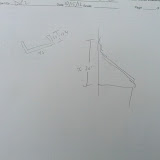The Wood Whisperer Guild is about to embark on their next group build -- the Tilt Top Table.
| Safety first . . . and second . . . and third . . . |
What is the Wood Whisperer Guild you ask? Surely you know already if you’re an active part of the online woodworking community. If you’re new, the Guild is the members section of the Wood Whisperer Site. Why be a member? There are many great reasons. If you’re not yet familiar with them, you can watch an exhausted and dreary eyed me talk about why the Guild is so great.
This build will be a neat project. It’s going to be a traditional tilt top table. While this traditional form of furniture isn’t quite to my taste, it is much to my wife’s. I’m sure that if it’s not quite your style either, someone you know will still love it.Regardless of style, it’s going to be an interesting build. It’ll be the first time a Guild Build breaks out the lathe. The flip top and gently splaying legs that extend the shape of the center turning will also be fun to build. Or you could bastardize the design and not turn or splay it, as I’d probably do.
That is the great thing about Guild Builds. Though it’s a community build of many Guild members building along with Marc, the project’s not as important as the community. I’ve never had as much fun building a project as I have with the Guild Builds I’ve participated in. Even when my own project veered off dramatically from the one Marc was building, it was still great to participate with the group and share the camaraderie that only comes from building along with a group. Short of sharing a classroom, the Wood Whisperer Guild is the best choice to enjoy you woodworking (and learn) with others.
Learn more about the table with Marcs introduction video.


























